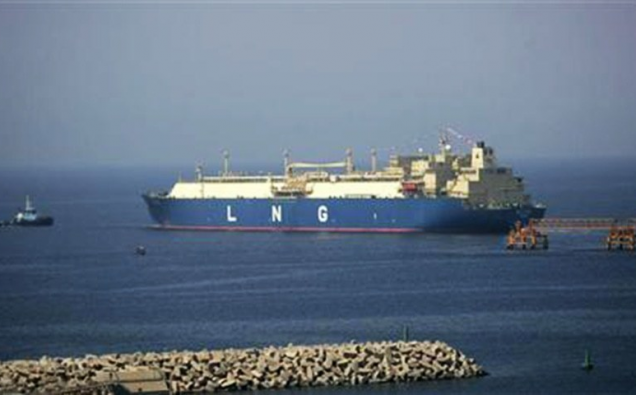
Belgian Vessel Exquisite docked at Port Qasim near Karachi has been instrumental in re-gasification of LNG imported from Qatar since March 2015.
Captain and engineers of European origin with the help of Philippines sailors carry out the operations aboard the ship weighing 83,163 tons whenever a fuel-laden vessel from the Gulf state is guided by the tug boats arrives.
“We enjoy re-gassification task while staying on the vessel; Ultimately, we are contributing to well being of a friendly country,” Captain of the ship, a Netherlander, says.
The Floating Storage and Re-Gasification Unit with a capacity of handling 600 million cubic feet of gas , has so far handled 1.7 million tons of slushy Liquefied Natural Gas (LNG) over the last 13 months , turning it into 77 billion cubic feet of methane.
The vessel, which is a Floating Storage and Re-Gasification Unit (FSRU) LNG tanker, has been contracted by a Pakistani company for a period of 15 years. Under an agreement signed between Pakistan and Qatar, LNG will be shipped to Pakistan for a period of 15 years at a price of 13 percent of crude oil.
Pakistan is among 15 countries in the world that have FSRU instead of land-based re-gasification infrastructure that could have incurred millions of additional dollars on the transportation of the LNG. The FSRU, twice the size of a football field, has an onboard plant to turn super-chilled liquid methane into gas from minus 160 degree centigrade to original gaseous state.
The imported gas, is then pumped into the system of Sui Southern Gas Company (SSGC) before its transfer into Sui Northern Gas Pipelines Limited (SNGPL) system for provision to the gas-starved central Pakistan province of Punjab.
With only 5 percent of total gas produced in Pakistan, Punjab consumes more than 60 percent of the available methane, mainly as domestic and industrial fuel. Before the import of LNG, gas supply to industry, power plants , fertilizer factories and CNG stations was completely suspended in winters to ensure smooth cooking in Punjab’s homes.
During winters, total gas demand in Pakistan shoots up to 6 billion cubic feet per day against availability of 4 billion cubic feet. Given the depletion of the gas reserves in Pakistan and around 10 percent per annum increase in the gas consumption, the shortfall is all set to touch new mark of 4 billion cubic feet within next 5 years.
” The import of LNG has helped increase the gas availability by 10 percent. Now industries, power plants and CNG stations are getting gas round the clock,” says Aamir Mahmood, manager ELENGY Terminal.
Presently, the LNG is being imported through state-owned oil marketing company, PSO. The vessel is utilizing only 66 percent of its capacity of handling and re-gassification. In case of government’s permission to private sector for import of LNG, this capacity can be utilized.
After the successful experience of FSRU ship at Port Qasim, Pakistan is also contemplating to have another floating storage and regassification facility at Gwadar Port. Energy experts believe that gas import is going to prove the ultimate solution of Pakistan’s energy crisis.














